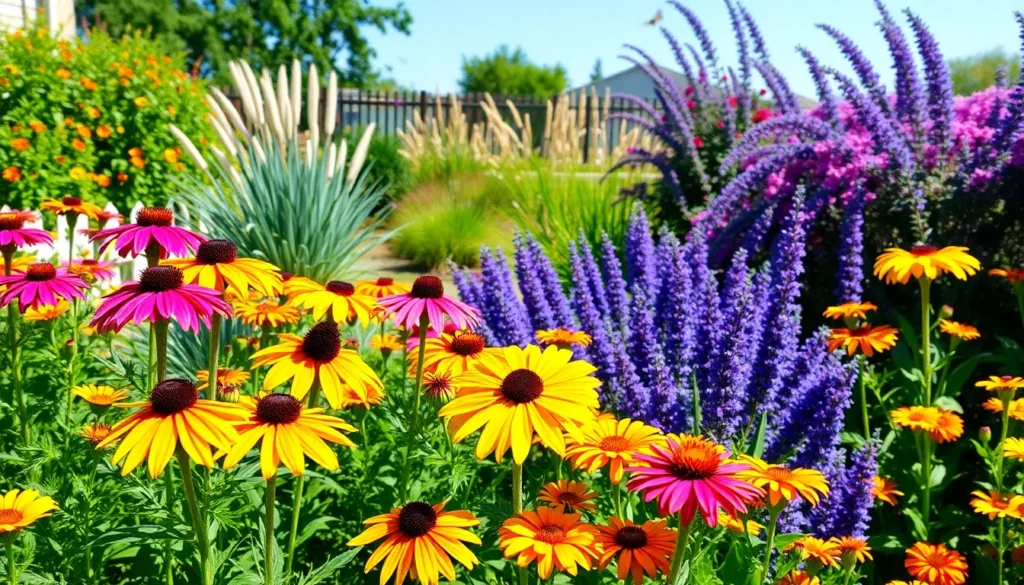Transforming your sun-drenched garden spaces into vibrant outdoor sanctuaries doesn’t have to feel overwhelming. We’ve all stood in our bright yards wondering which plants can actually thrive under those intense rays without constant watering or special care.
The secret lies in choosing the right sun-loving plants that naturally flourish in full sunlight conditions. These hardy varieties have evolved to embrace direct sunlight rather than merely tolerate it – turning what might seem like challenging growing conditions into their greatest advantage.
Whether you’re dealing with a south-facing backyard that gets eight hours of blazing sun or a rooftop garden that bakes all day long we’ll show you exactly which plants will transform your sunny spots into stunning displays of color and texture. From drought-resistant perennials to heat-loving annuals these selections will give you the thriving garden you’ve always wanted.
Choose Heat-Tolerant Perennials for Long-Lasting Color
Heat tolerant perennials offer stunning color year after year while thriving in intense sunlight conditions. These resilient plants establish deep root systems that help them survive scorching temperatures and drought periods.
Black-Eyed Susan (Rudbeckia)
Black-eyed Susan creates brilliant golden displays from midsummer through fall in full sun gardens. We love how these cheerful flowers attract butterflies and beneficial insects while requiring minimal water once established. The bright yellow petals surrounding dark centers make excellent cut flowers for indoor arrangements.
Rudbeckia varieties range from compact 12-inch plants to towering 8-foot giants like Rudbeckia maxima. Most gardeners prefer the classic Rudbeckia fulgida ‘Goldsturm’ which grows 18-24 inches tall and spreads naturally to form colorful colonies. These plants self-seed readily, creating new patches of color throughout sunny garden beds.
Purple Coneflower (Echinacea)
Purple coneflower produces stunning blooms in shades of pink, white, coral, and traditional purple from early summer until frost. We recommend planting multiple varieties to extend the blooming season and create diverse color combinations. The distinctive cone-shaped centers attract goldfinches and other seed-eating birds during autumn months.
Echinacea purpurea tolerates poor soil conditions and extreme heat better than most flowering perennials. Modern cultivars like ‘Magnus’ and ‘White Swan’ offer improved flower size and stronger stems. These plants typically reach 2-4 feet in height and benefit from deadheading to encourage continuous blooming.
Sedum and Succulents
Sedum varieties provide exceptional drought tolerance while offering diverse textures and colors for sunny garden spaces. We particularly appreciate how these plants store water in their thick, fleshy leaves, making them perfect for areas with limited irrigation. Popular choices include Sedum spectabile ‘Autumn Joy’ and Sedum telephium ‘Matrona’.
Succulent perennials like hens and chicks (Sempervivum) create living carpets that require virtually no maintenance once established. These plants multiply naturally through offsets, filling in gaps between rocks and expanding coverage over time. Stonecrop varieties bloom in late summer with clusters of pink, red, or white flowers that attract late season pollinators.
Select Drought-Resistant Annuals for Seasonal Displays
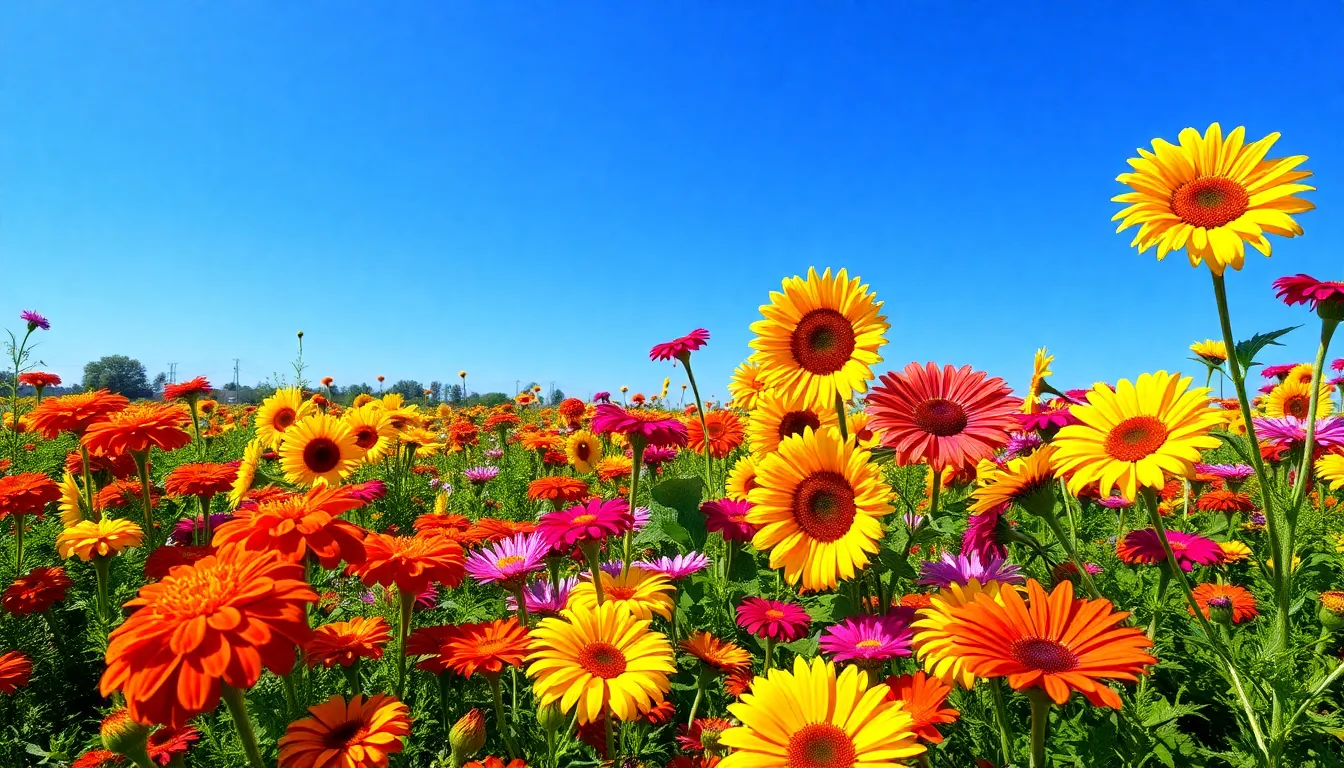
Beyond perennials, we can enhance our sunny gardens with vibrant annuals that bring seasonal color while requiring minimal water. These drought-resistant options provide continuous blooms throughout growing seasons.
Marigolds and Zinnias
Marigolds offer exceptional performance in hot, sunny conditions with their bright orange and yellow blooms that thrive even in drought-prone areas. These Tagetes species require minimal watering once established and continue producing colorful flowers throughout summer months. We’ll find them particularly valuable for their low-maintenance nature and ability to withstand intense heat.
Zinnias complement marigolds perfectly as heat-loving annuals that flourish in full sun and dry soils. Their daisy-like flowers create stunning displays while attracting butterflies and beneficial pollinators to our gardens. Both varieties work exceptionally well in sunny borders where other plants might struggle with water limitations.
Portulaca and Moss Rose
Portulaca grandiflora, commonly known as Moss Rose, stands out for its remarkable drought tolerance thanks to succulent leaves and stems that store water efficiently. This low-growing annual produces vibrant blooms in pink, red, yellow, orange, and white shades that open during sunny periods.
We recommend Moss Rose for ground cover applications, rock gardens, or hanging baskets where its spreading habit creates dense color carpets. The plant thrives in full sun with well-drained soil and requires minimal care once established, making it ideal for harsh sunlight conditions and scarce water situations.
Sunflowers and Cosmos
Sunflowers bring dramatic vertical interest to sunny spaces with their large, cheerful blooms and moderate drought tolerance that suits hot, dry climates. These sun-loving giants create focal points while requiring only weekly watering during dry spells.
Cosmos provide delicate contrast with their feathery foliage and daisy-like flowers that thrive in full sun and poor soil conditions. These drought-tolerant annuals produce continuous blooms throughout summer while attracting pollinators and adding graceful movement to garden designs. Both species excel in water-wise landscapes where we need reliable color without intensive irrigation demands.
Plant Native Grasses for Low-Maintenance Landscapes
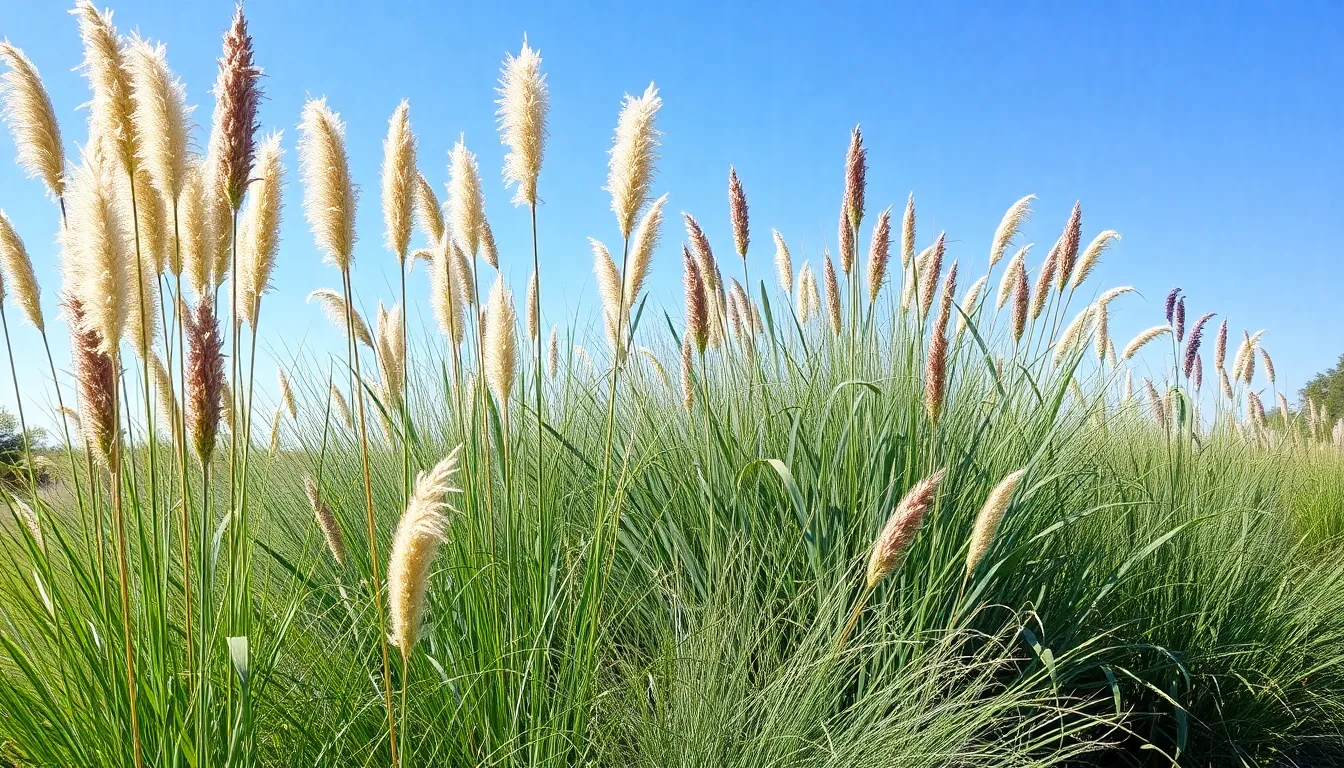
We can elevate our sunny garden spaces with native grasses that provide year-round structure while requiring minimal care. These resilient plants offer textural variety and graceful movement when breezes flow through their foliage.
Ornamental Fountain Grass
Ornamental fountain grass delivers exceptional drought tolerance with its graceful, arching foliage that creates stunning focal points in sunny locations. This decorative grass produces feathery flower spikes that add vertical interest throughout the growing season. We find its cascading growth habit perfect for borders and container gardens where dramatic texture is desired. The plant thrives in full sun conditions and requires minimal watering once established, making it ideal for low-maintenance landscapes.
Blue Fescue and Buffalo Grass
Blue fescue forms compact clumps with fine blue-gray foliage that works beautifully in sunny borders and rock gardens. This versatile grass maintains its attractive color throughout the season and pairs well with flowering perennials. Buffalo grass offers remarkable heat and drought tolerance as a native prairie species that’s perfectly suited for sunny, dry sites. We recommend buffalo grass for areas where traditional lawn grasses struggle, as it can withstand extreme weather conditions while providing ground coverage.
Switchgrass and Little Bluestem
Switchgrass (Panicum virgatum) thrives in full sun and adapts to various soil conditions while producing attractive seed heads that provide winter interest. This upright grass grows in clumps and offers structural appeal that complements both wildflower plantings and formal garden designs. Little bluestem (Schizachyrium scoparium) features blue-green foliage that transforms to reddish-orange in fall, creating spectacular seasonal color displays. We value little bluestem for its versatility, as it performs exceptionally well in full sun conditions and works as both specimen plantings and mass groupings. Both grasses support pollinators and wildlife while providing resistance to deer browsing, making them excellent choices for sustainable sunny landscapes.
Incorporate Flowering Shrubs for Structure and Blooms
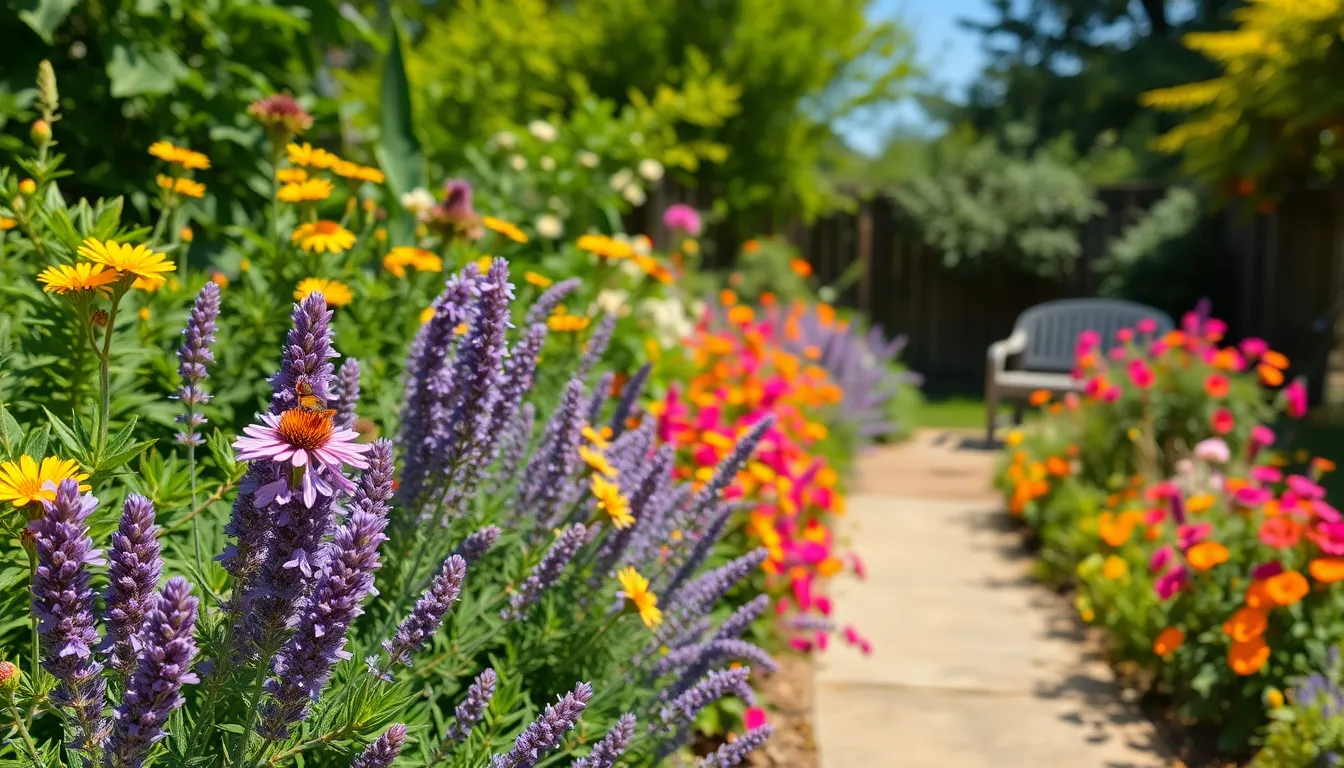
We’ll now explore flowering shrubs that provide both architectural backbone and stunning seasonal displays in your sunny garden spaces.
Lavender and Rosemary
Lavender creates fragrant purple flower spikes while delivering exceptional drought tolerance in full sun locations. Mediterranean gardens benefit tremendously from this hardy shrub that attracts pollinators throughout the growing season. Rosemary complements lavender perfectly with its aromatic evergreen foliage and delicate blue flowers that appear sporadically year round.
Both shrubs require well-drained soil and thrive with minimal water once established. We recommend planting them near pathways or seating areas where you can enjoy their wonderful fragrances. These herbs also serve double duty as culinary additions to your kitchen garden.
Butterfly Bush and Spirea
Butterfly bush produces long, colorful flower spikes that create spectacular displays from summer through fall. Pollinators flock to these nectar-rich blooms, making your garden a haven for butterflies and hummingbirds. The shrub’s vigorous growth habit provides excellent screening potential for sunny borders.
Spirea offers clusters of tiny flowers in pink, white, or red hues that cover the entire plant during peak blooming periods. We appreciate its low maintenance requirements and reliable performance in hot, sunny conditions. Many spirea varieties also provide attractive fall foliage colors as an added bonus.
Rose of Sharon and Barberry
Rose of Sharon delivers large, hibiscus-like flowers in late summer when many other shrubs have finished blooming. This robust shrub tolerates both full sun and partial shade conditions while requiring minimal care once established. The tropical-looking blooms come in various colors including white, pink, purple, and blue.
Barberry shrubs provide year-round interest with colorful foliage ranging from bright green to deep burgundy red. We value their versatility as both structural hedge plants and accent specimens in sunny industry designs. Their drought tolerance and low maintenance requirements make them ideal choices for challenging hot, sunny locations where other plants might struggle.
Add Climbing Vines for Vertical Interest
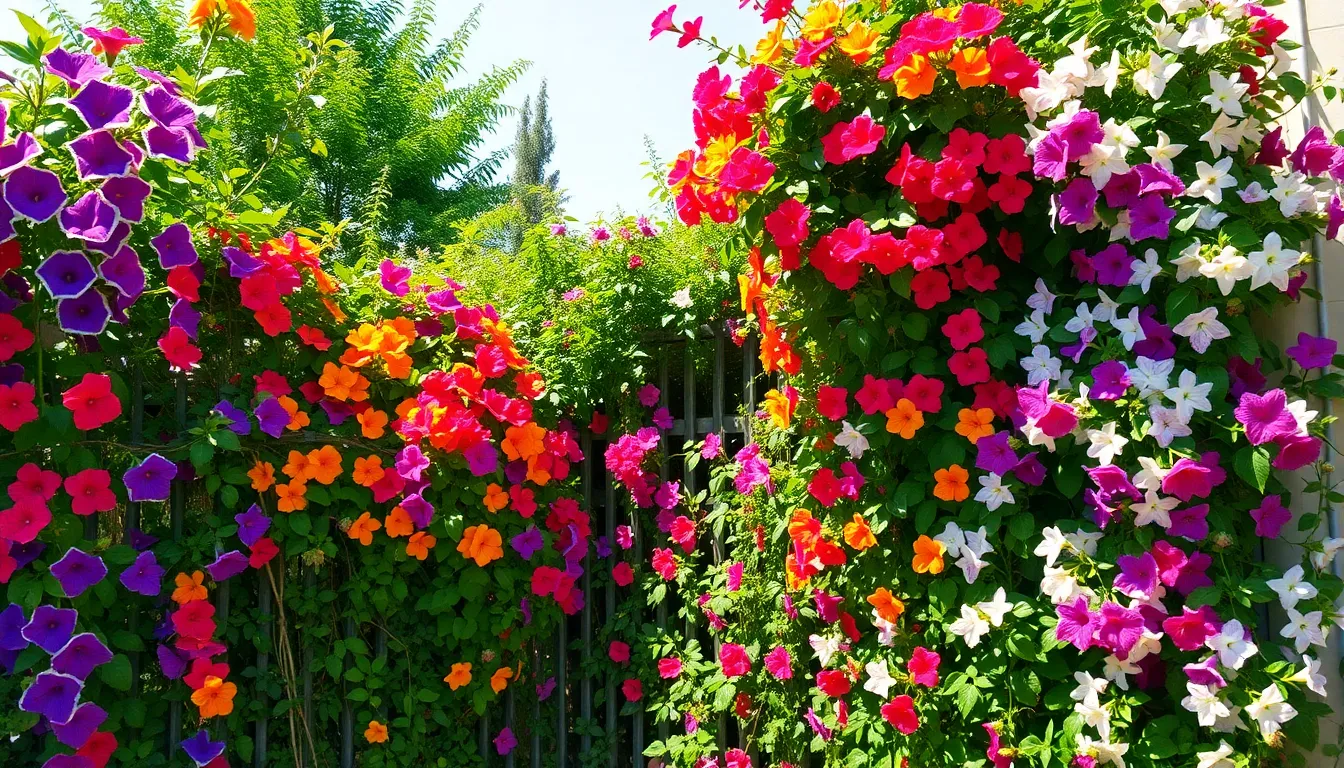
Transform your sunny garden’s vertical spaces into stunning living walls with these robust climbing vines. These sun loving plants create dramatic height while maximizing your garden’s dimensional appeal.
Morning Glory and Clematis
Morning Glory (Ipomoea spp.) delivers fast growing coverage with vibrant trumpet shaped flowers that thrive in full sun conditions. We recommend this vigorous climber for quick results, as it rapidly covers structures while providing vivid color from summer through fall. The flowers open each morning to reveal brilliant blues, purples, pinks, and whites that create stunning focal points.
Clematis varieties flourish in sunny locations when planted in well drained soil, producing large showy flowers across multiple bloom times throughout the growing season. We find clematis particularly valuable because different varieties offer staggered flowering periods, extending your garden’s visual interest from spring through fall. These elegant vines produce flowers in diverse colors including deep purples, bright pinks, crisp whites, and rich burgundies.
Honeysuckle and Trumpet Vine
Honeysuckle (Lonicera spp.) grows vigorously in sunny spots while producing fragrant tubular flowers that attract hummingbirds and beneficial pollinators to your garden space. We appreciate honeysuckle’s hardy nature and its ability to quickly establish itself on fences, arbors, and trellises. The sweet scented blooms appear in clusters of cream, yellow, pink, or red throughout the growing season.
Trumpet Vine (Campsis radicans) thrives as a vigorous grower with bright orange red trumpet flowers that create striking vertical accents in full sun environments. We recommend trumpet vine for gardeners seeking dramatic impact, as its bold blooms attract hummingbirds while providing intense color against walls and structures. This hardy climber tolerates poor soil conditions and establishes quickly once planted.
Climbing Roses and Jasmine
Climbing Roses love full sun exposure and well drained soil conditions, producing abundant fragrant blooms that elegantly cover trellises and arbors throughout the growing season. We suggest selecting repeat blooming varieties to ensure continuous flower production from spring through fall. These roses offer classic beauty with their large, fragrant flowers in colors ranging from soft pastels to deep reds.
Jasmine (Jasminum spp.) prefers sunny conditions and rewards gardeners with intensely fragrant flowers that create aromatic garden walls and fence coverings. We find jasmine particularly valuable for evening gardens, as many species release their strongest fragrance during twilight hours. The small, star shaped white or yellow flowers appear in clusters and fill the air with their distinctive sweet perfume.
Include Herbs That Thrive in Full Sun
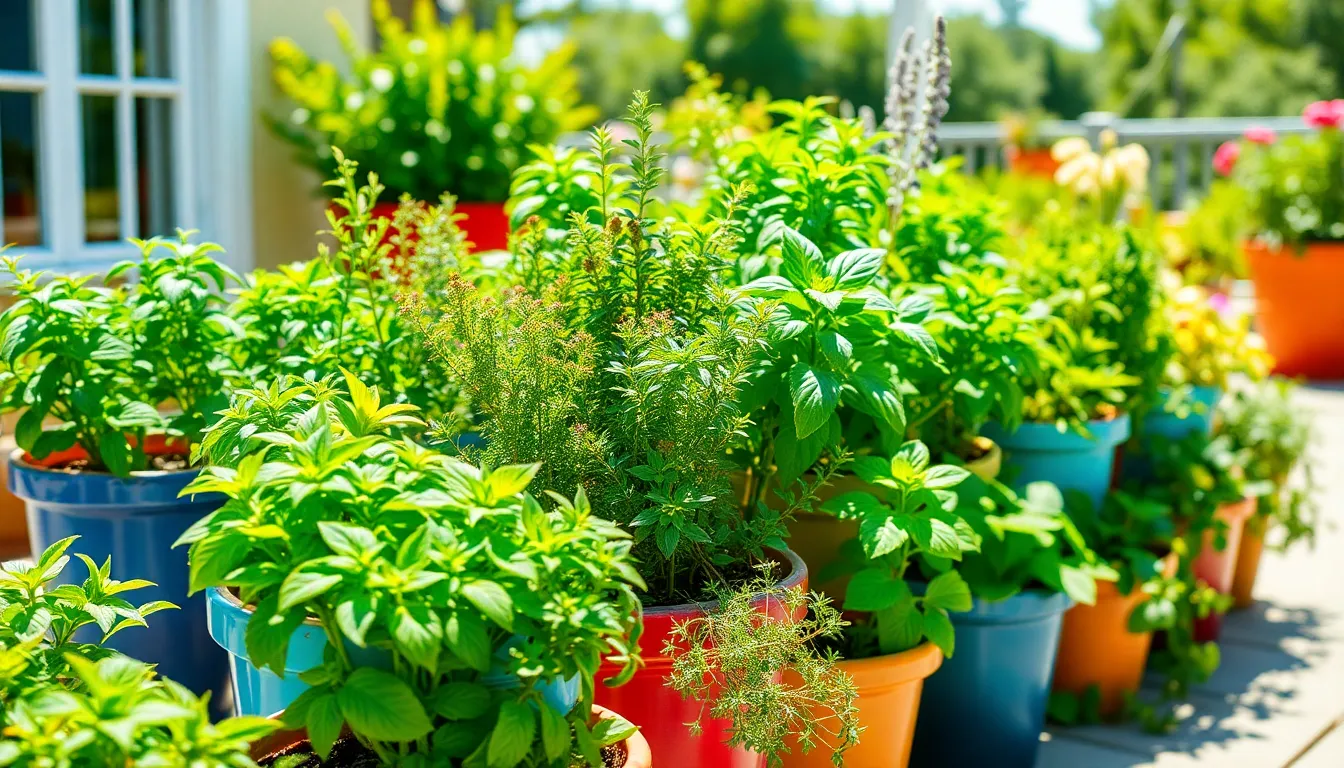
Adding culinary herbs to sunny garden spaces creates a practical and aromatic enhancement to our industry design. These versatile plants offer both functional and aesthetic value while thriving in the same bright conditions as our other sun-loving selections.
Mediterranean Herbs (Oregano, Thyme, Sage)
Oregano delivers exceptional performance in full sun locations with its ability to reach 65 cm in height while producing abundant aromatic leaves. Growing oregano in nutrient-poor, dry soil actually enhances its flavor intensity, making it perfect for sunny garden beds or container gardening on bright patios. Cold-hardy varieties can withstand temperatures down to -15°C, ensuring year-round garden presence in many climates.
Thyme thrives in hot, dry conditions that mirror its native Mediterranean environment, requiring minimal water once established. Planting thyme in sunny locations ensures robust growth and concentrated essential oils that enhance culinary applications. Multiple varieties offer different flavors and textures while maintaining the same sun-loving characteristics.
Sage flourishes in full sun environments with its silvery foliage providing attractive contrast to other garden plants. Establishing sage in sunny, well-draining locations promotes healthy growth and prevents root rot issues common in shadier, moisture-retentive areas. Harvesting sage regularly encourages bushy growth and prevents woody stems from developing.
Basil and Cilantro Varieties
Basil produces its most flavorful leaves when grown in full sun with consistently moist, warm soil conditions. Protecting basil from blazing midday heat ensures optimal growth while maintaining the sun exposure necessary for essential oil production. Varieties like cinnamon, anise, lemon, and Thai basil each offer unique flavor profiles while sharing the same sunny growing requirements.
Growing basil outdoors or indoors requires consistent sunlight exposure of at least six hours daily for proper development. Container growing allows us to move basil to optimal sunny locations throughout the day while protecting it from extreme weather conditions. Some hardy basil varieties can even survive winter conditions with proper care and protection.
Cilantro develops properly in full sun but requires monitoring during extremely hot summer weather to prevent premature bolting. Planting cilantro in spring and fall provides the best growing conditions, allowing it to benefit from full sun without excessive heat stress. Successive plantings every few weeks ensure continuous harvests throughout the growing season.
Mint and Lemon Balm
Mint tolerates full sun conditions when provided with adequate water, though it typically prefers some shade during peak heat hours. Container growing prevents mint’s invasive spreading while allowing us to position it in optimal sunny locations with controlled moisture levels. Regular watering ensures mint maintains its vigorous growth in sunny exposures.
Lemon balm grows successfully in full sun while often benefiting from midday shade protection during extreme heat periods. Controlling lemon balm’s rapid spreading through container growing or bordered plantings prevents it from overwhelming other garden plants. Fertilizer requirements remain minimal, making lemon balm an easy-care addition to sunny herb gardens.
Harvesting lemon balm regularly encourages fresh growth and prevents the plant from becoming too woody or aggressive in sunny garden spaces. Drying harvested leaves preserves the lemony fragrance for year-round use in teas and culinary applications. Strategic placement in sunny spots maximizes growth while allowing easy access for regular harvesting and maintenance.
Consider Cacti and Desert Plants for Extreme Heat
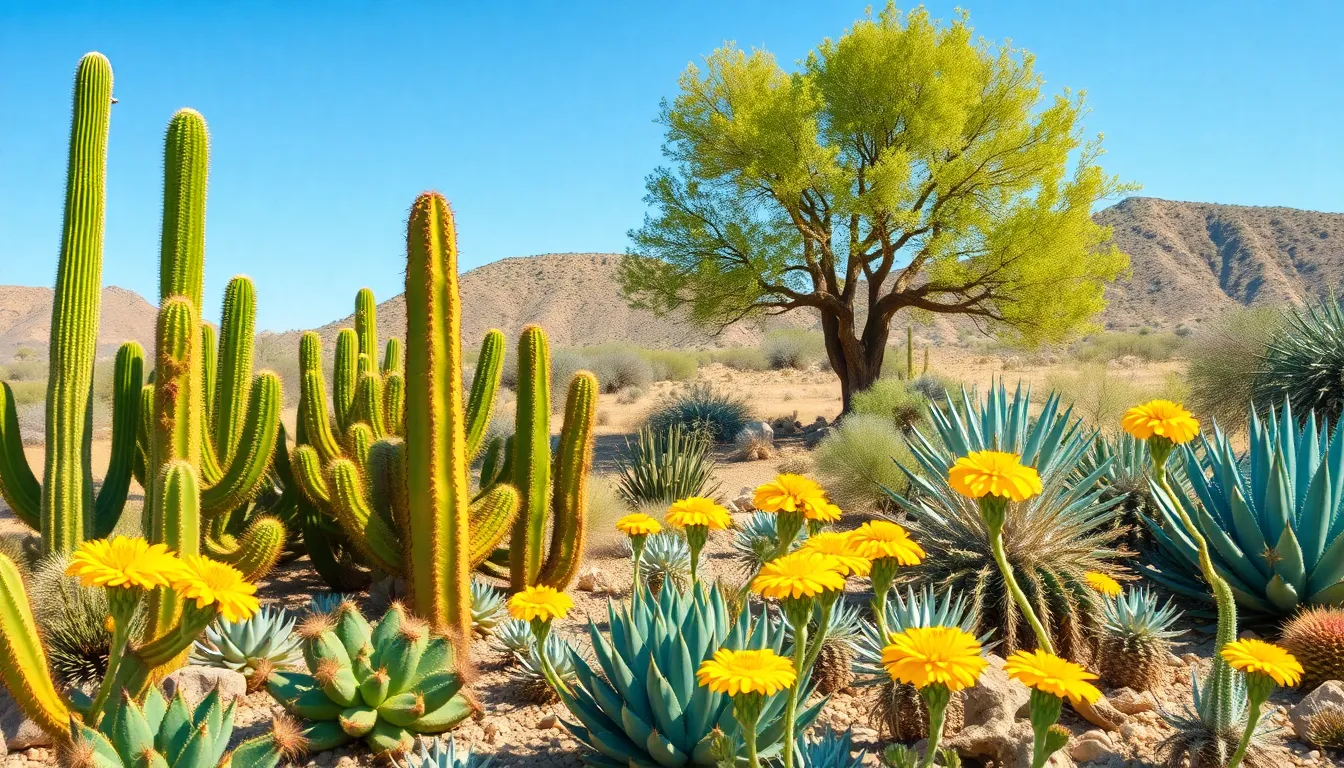
When garden temperatures soar beyond what traditional plants can handle, we turn to nature’s ultimate survivors. Cacti and desert plants have evolved remarkable adaptations that make them perfect for the most challenging sunny conditions.
Prickly Pear and Barrel Cactus
Prickly Pear cacti stand out as iconic desert survivors with their distinctive broad, flat pads that function as water storage tanks. These remarkable plants store moisture in their thick, fleshy segments while their spine covered surfaces protect against predators and reduce water loss through transpiration. We particularly appreciate how Prickly Pear produces edible fruits that add both ornamental and practical value to sunny landscapes.
Barrel Cactus displays its water conservation mastery through its round, ribbed structure that expands and contracts based on water availability. This spherical design maximizes water storage while minimizing surface area exposed to the sun’s intense rays. Both varieties thrive under full sun exposure and require minimal irrigation once established, making them ideal choices for gardeners dealing with extreme heat and drought conditions.
Agave and Yucca Plants
Agaves showcase their drought tolerance through rosettes of thick, pointed leaves equipped with specialized water storage tissues and waxy coatings. These structural adaptations dramatically reduce water loss while the plant’s succulent leaves store precious moisture for extended dry periods. Desert landscapers frequently choose agaves for their architectural form and exceptional heat resistance.
Yucca plants complement agaves perfectly with their sword shaped leaves and impressive flower spikes that can reach towering heights. Their thick, waxy leaf surfaces minimize water evaporation while the plant’s deep root system taps into underground moisture sources. Both plants flourish in well draining soil under full sun exposure, handling extreme temperatures that would stress most conventional garden plants.
Desert Marigold and Palo Verde
Desert Marigold brightens arid landscapes with its cheerful yellow, daisy shaped flowers while demonstrating remarkable water conservation abilities. This perennial stores moisture in both its leaves and stems, allowing it to survive extended periods without rainfall while maintaining continuous blooms throughout the growing season.
Palo Verde trees provide filtered shade in desert gardens through their unique green bark that performs photosynthesis when leaves drop during extreme drought. Their small leaf size reduces water loss through transpiration, while vibrant yellow flowers add seasonal color to hot, sunny spaces. We recommend both plants for gardeners seeking low maintenance options that thrive in the most challenging sunny conditions while providing visual interest year round.
Plan for Seasonal Interest with Bulbs and Tubers
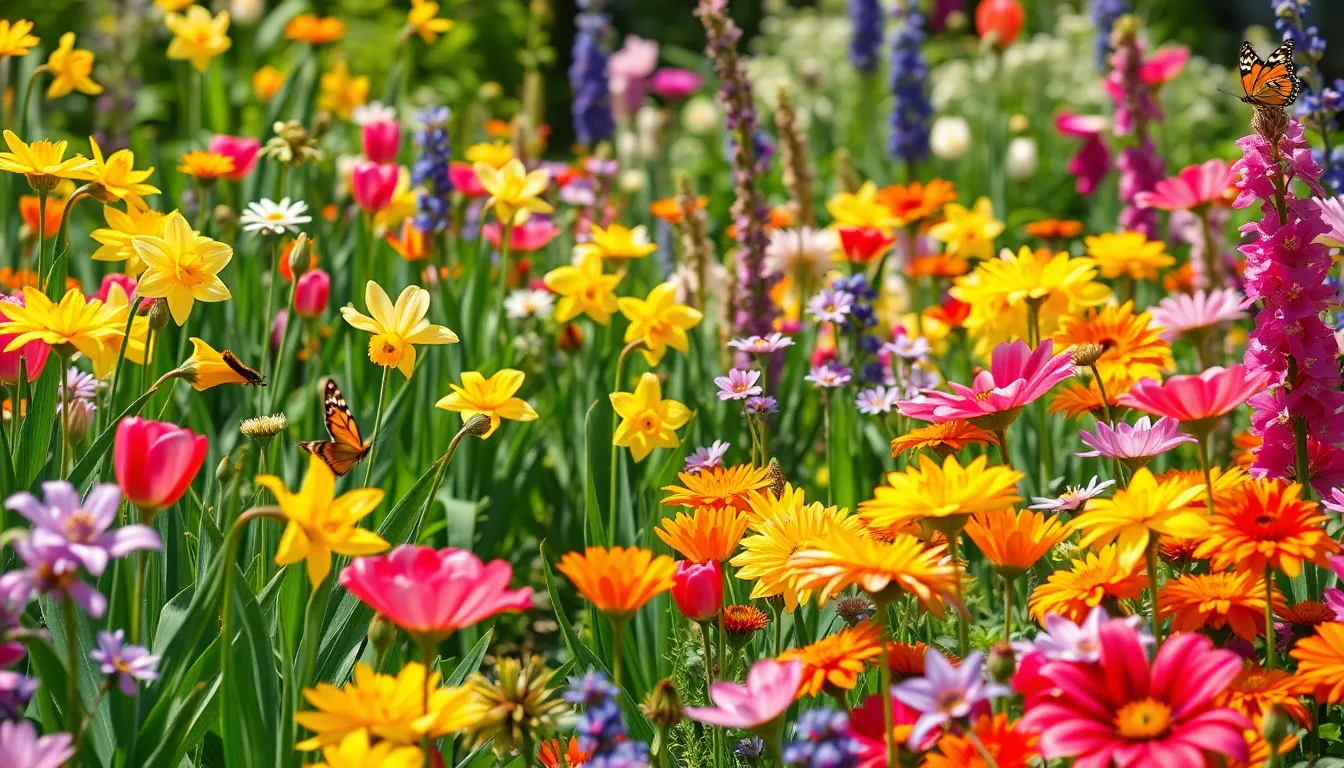
Creating continuous color in sunny gardens becomes effortless when we incorporate bulbs and tubers for year-round interest. These sun-loving plants provide spectacular displays while requiring minimal maintenance once established.
Spring Bulbs (Tulips and Daffodils)
Tulips deliver vibrant early season color in sunny locations with well-drained soil. Their diverse palette of colors creates stunning focal points after winter’s dormancy ends. We recommend planting tulip bulbs in fall for spectacular spring displays that brighten gardens from March through May.
Daffodils provide bright, cheerful blooms that thrive exceptionally well in full sun conditions. These hardy perennials flourish across zones 3-8, making them reliable choices for early spring gardens. Their natural resistance to deer and rodents ensures consistent yearly returns without replacement needs.
Summer Bulbs (Gladiolus and Dahlias)
Gladiolus creates dramatic vertical interest in sunny garden beds during peak summer months. These tall-stemmed beauties prefer full sun exposure and produce sword-like flower spikes in multiple colors. We plant gladiolus bulbs after soil temperatures reach 60°F for optimal growth and flowering.
Dahlias offer striking colors and forms when planted in sunny spots with good air circulation. Their wide range of bloom sizes and shapes provides endless design possibilities for summer gardens. Regular deadheading extends their flowering period from midsummer until the first frost arrives.
Fall-Blooming Options
Agastache (hummingbird mint) blooms from summer into fall while featuring aromatic foliage that attracts pollinators like hummingbirds and butterflies. This drought-tolerant perennial thrives in zones 3-10 and maintains deer resistance throughout growing seasons. Its extended blooming period bridges the gap between summer and autumn garden displays.
Black-eyed Susan and Bee Balm perform exceptionally well in sunlit gardens during fall months. These perennials offer continuous blooms and structural interest when many other plants begin declining. Their pollinator-friendly flowers support beneficial insects while providing late-season color in sunny landscapes.
Conclusion
Creating a thriving sunny garden doesn’t have to be challenging when you choose the right plants. We’ve explored an extensive range of options from drought-resistant perennials and heat-loving annuals to native grasses and architectural shrubs that’ll transform your bright spaces into stunning outdoor retreats.
The key to success lies in selecting plants that naturally love intense sunlight rather than fighting against your garden’s conditions. Whether you’re drawn to the fragrant blooms of Mediterranean herbs or the dramatic presence of desert cacti each category offers unique benefits for your industry.
Remember that sunny gardens can be both beautiful and practical. By incorporating climbing vines for vertical interest and seasonal bulbs for year-round color you’ll create a ever-changing space that evolves throughout the seasons while requiring minimal maintenance once established.
Frequently Asked Questions
What are the best sun-loving perennials for hot, sunny gardens?
Black-Eyed Susan (Rudbeckia) and Purple Coneflower (Echinacea) are excellent choices for sunny gardens. These hardy perennials produce vibrant blooms and thrive in poor soil conditions with extreme heat. Sedum and other succulents also provide exceptional drought tolerance while adding diverse textures to your garden design.
Which annual flowers work best in drought conditions?
Marigolds and Zinnias are top performers in hot, sunny conditions while attracting beneficial pollinators. Portulaca (Moss Rose) offers remarkable drought tolerance with colorful blooms. Sunflowers and Cosmos create dramatic displays and thrive in dry climates, making them perfect for water-wise landscaping projects.
How can native grasses enhance my sunny garden?
Native grasses like Ornamental Fountain Grass provide year-round structure with minimal maintenance requirements. Blue Fescue and Buffalo Grass offer attractive appearance and resilience in dry conditions. Switchgrass and Little Bluestem adapt well to various conditions while supporting local wildlife and pollinators throughout the growing season.
What flowering shrubs thrive in full sun?
Lavender and Rosemary are ideal Mediterranean garden choices, offering drought tolerance and fragrant blooms. Butterfly Bush and Spirea produce vibrant flowers that attract pollinators. Rose of Sharon provides late-summer color, while Barberry adds colorful foliage and versatility to sunny garden spaces year-round.
Which climbing vines work well in sunny locations?
Morning Glory and Clematis offer fast growth with vibrant, eye-catching flowers. Honeysuckle and Trumpet Vine provide fragrant blooms while attracting beneficial pollinators. Climbing Roses and Jasmine combine beauty with aromatic qualities, creating stunning living walls that maximize vertical garden space effectively.
What culinary herbs grow best in full sun?
Mediterranean herbs like Oregano, Thyme, and Sage flourish in bright conditions while providing unique flavors for cooking. Basil and Cilantro thrive with sun-loving requirements. Mint and Lemon Balm adapt well to sunny environments and require minimal care, making them perfect for beginner herb gardeners.
Which desert plants handle extreme heat conditions?
Prickly Pear and Barrel Cactus excel in water conservation with minimal irrigation needs. Agave and Yucca plants provide architectural forms with exceptional drought resistance. Desert Marigold and Palo Verde offer vibrant blooms with low maintenance requirements, thriving in the most challenging sunny garden conditions.
How can bulbs extend color throughout the year?
Spring bulbs like Tulips and Daffodils provide early vibrant blooms. Summer options such as Gladiolus and Dahlias create dramatic seasonal displays. Fall-blooming choices like Agastache, Black-eyed Susan, and Bee Balm offer late-season interest, ensuring continuous color in your sunny garden throughout all growing seasons.

